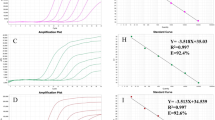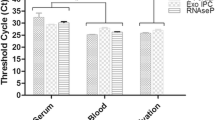Abstract
In this paper, we examined the diagnostic value of a real-time polymerase chain reaction (PCR) using fluorescence resonance energy transfer (TaqMan assay) with a new set of primers and probe targeting the B1 gene to reproducibly detect and quantify Toxoplasma gondii in human blood. A total of 183 buffy coat samples from patients serologically classified as recent toxoplasmosis (immunoglobulin M (IgM)+, n = 35) or chronic infection (IgM− and immunoglobulin G (IgG)+, n = 110), and seronegative individuals (n = 38) was investigated. Of the IgM seropositive patients, 17:35 (48.6%) presented parasitaemia, whereas 3.6% positivity was achieved in those individuals that theoretically corresponded to chronic infection (4:110). In the seronegative group, the assay provided 7.9% (3/38) of positive results. Interestingly, one of them was confirmed as positive in a conventional PCR targeting the Toxoplasma B1 gene after hybridization with an internal probe. Real-time PCR was able to accurately quantify the parasite load when concentrations of T. gondii DNA are low, revealing a parasite burden ranged from 9.92 × 10−3 to 8.73 × 10−1 tachyzoites genome per milliliter of blood. The chance of an IgM+ patient to present parasitemia detected by the TaqMan procedure was 19.02 times greater than in IgM− individuals (P < 0.05). It was observed a positive association between the optical density values of the IgM serological tests and the number of circulating parasites in the acute patients (P < 0.0001). The specificity of the molecular test was 95.3% when calculated using IgM+ patients as disease group and IgM− as nondisease group. The low sensitivity observed in the IgM seropositive group (48.6%) could be due to the use of buffy coat as clinical material for DNA extraction. An amplification control based on the human β-actin gene was used in parallel to monitor PCR inhibition and to control for DNA integrity.

Similar content being viewed by others
References
Bastien P (2002) Molecular diagnosis of toxoplasmosis. Trans R Soc Trop Med Hyg 96:S205–S215
Bretagne S, Costa JM, Fleury-Feith J, Poron F, Dubreuil-Lemaire ML, Vidaud M (1995) Quantitative competitive PCR with bronchoalveolar lavage fluid for diagnosis of toxoplasmosis in AIDS patients. J Clin Microbiol 33:1662–1664
Buchbinder S, Blatz R, Rodloff AC (2003) Comparison of real-time PCR detection methods for B1 and P30 genes of Toxoplasma gondii. Diagn Microbiol Infect Dis 45:269–271
Burg JL, Grover CM, Pouletty P, Boothroyd JC (1989) Direct and sensitive detection of a pathogenic protozoan, Toxoplasma gondii, by polymerase chain reaction. J Clin Microbiol 27:1787–1792
Cantos GA, Prando MD, Siqueira MV, Teixeira RM (2000) Toxoplasmose: Ocorrência de anticorpos anti-Toxoplasma gondii e diagnóstico. Rev Assoc Med Bras 46:335–341
Cassaing S, Bessières MH, Berry A, Berrebi A, Fabre R, Magnaval JF (2006) Comparison between two amplification sets for molecular diagnosis of toxoplasmosis by real-time PCR. J Clin Microbiol 44:720–724
Coelho RAI, Kobayashi M, Carvalho LB Jr (2003) Prevalence of IgG antibodies specific to Toxoplasma gondii among blood donors in Recife, Northeast Brazil. Rev Inst Med Trop Sao Paulo 45:229–231
Contini C, Seraceni S, Cultrera R (1999) Different PCR systems to detect Toxoplasma gondii tachyzoites or bradyzoites in clinical specimens from patients with and without overt disease. J Eukaryot Microbiol 46:S77–S78
Contini C, Cultrera R, Seraceni S, Segala D, Romani R, Fainardi E, Cinque P, Lazzarin A, Delia S (2002) The role of stage-specific oligonucleotide primers in providing effective laboratory support for the molecular diagnosis of reactivates Toxoplasma gondii encephalitis in patients with AIDS. J Med Microbiol 51:879–890
Costa JM, Pautas C, Ernault P, Foulet F, Cordonnier C, Bretagne S (2000) Real-time PCR for diagnosis and follow-up of Toxoplasma reactivation after allogeneic stem cell transplantation using fluorescence resonance energy transfer hybridization probes. J Clin Microbiol 38:2929–2932
Costa JM, Ernault P, Gautier E, Bretagne S (2001) Prenatal diagnosis of congenital toxoplasmosis by duplex real-time PCR using fluorescence resonance energy transfer hybridization probes. Prenat Diagn 21:85–88
Grob U, Roggenkamp A, Janitschke K, Heesemann J (1992) Improved sensitivity of the polymerase chain reaction for detection of Toxoplasma gondii in biological and human clinical specimens. Eur J Clin Microbiol Infect Dis 11:33–39
Guy EC, Joynson HM (1995) Potential of the polymerase chain reaction in the diagnosis of active Toxoplasma infection by detection of parasite in blood. J Infect Dis 172:319–322
Hierl T, Reischl U, Lang P, Hebart H, Stark M, Kyme P, Autenrieth IB (2004) Preliminary evaluation of one conventional nested and two real time PCR assays for the detection of Toxoplasma gondii in immunocompromised patients. J Med Microbiol 53:1–4
Hitt JA, Filice GA (1992) Detection of Toxoplasma gondii parasitemia by gene amplification, cell culture, and mouse inoculation. J Clin Microbiol 30:3181–3184
Ho-Yen DO, Joss AW, Balfour AH, Smyth ETM, Baird D, Chatterton JMW (1992) Use of the polymerase chain reaction to detect Toxoplasma gondii in human blood samples. J Clin Pathol 45:910–913
James GS, Sintchenko VG, Dickeson DJ, Gilbert GL (1996) Comparison of cell culture, mouse inoculation, and PCR for detection of Toxoplasma gondii: effects of storage conditions on sensitivity. J Clin Microbiol 34:1572–1575
Johnson JD, Butcher PD, Savva D, Holliman RE (1993) Application of the polymerase chain reaction to the diagnosis of human toxoplasmosis. J Infect 26:147–158
Khoury H, Adkins D, Brown R, Goodnough L, Gokden M, Roberts T, Storch G, DiPersio J (1999) Successful treatment of cerebral toxoplasmosis in a marrow transplant recipient: contribution of a PCR test in diagnosis and early detection. Bone Marrow Transplant 14:409–411
Kompalic-Cristo A, Nogueira SA, Guedes AL, Frota C, González LF, Brandão A, Amendoeira MR, Britto C, Fernandes O (2004) Lack of technical specificity in the molecular diagnosis of toxoplasmosis. Trans R Soc Trop Med Hyg 98:92–95
Martino R, Bretagne S, Einsele H, Maertens J, Ullmann AJ, Parody R, Schumacher U, Pautas C, Theunissen K, Schindel C, Munoz C, Margali N, Cordonnier C (2005) Early detection of Toxoplasma infection by molecular monitoring of Toxoplasma gondii in peripheral blood samples after allogeneic stem cell transplantation. Clin Infect Dis 40:67–78
Mei-Hui L, Tse-Ching C, Tseng-Tong K, Ching-Chung T, Ching-Ping T (2000) Real-Time PCR for quantitative detection of Toxoplasma gondii. J Clin Microbiol 38:4121–4125
Montoya JG (2002) Laboratory diagnosis of Toxoplasma gondii infection and toxoplasmosis. J Infect Dis 185:S73–S82
O’Driscoll JC, Holliman RE (1991) Toxoplasmosis and bone marrow transplantation. Rev Med Microbiol 2:215–222
Pelloux H, Weiss J, Simon J, Muet F, Fricker-Hidalgo H, Goullier-Fleuret A, Ambroise-Thomas P (1996) A new set of primers for the detection of Toxoplasma gondii in amniotic fluid using polymerase chain reaction. FEMS Microbiol Lett 138:11–15
Pelloux H, Dupoy-Camet J, Derouin F, Aboulker JP, Raffi F, the Bio-Toxo Study Group (1997) A multicentre prospective study for the polymerase chain reaction detection of Toxoplasma gondii DNA in blood samples from 186 AIDS patients with suspected toxoplasmic encephalitis. AIDS 11:1888–1890
Reischl U, Bretagne S, Krüger D, Ernault P, Costa JM (2003) Comparison of two DNA targets for the diagnosis of toxoplasmosis by real-time PCR using fluorescence resonance energy transfer hybridization probes. BMC Infect Dis 3:7–15
Remington J, Thulliez P, Montoya JG (2004) Recent developments for diagnosis of toxoplasmosis. J Clin Microbiol 42:941–945
Romand S, Chosson M, Franck J, Wallon M, Kieffer F, Kaiser K, Dumon H, Peyron F, Thulliez P, Picot S (2004) Usefulness of quantitative polymerase chain reaction in amniotic fluid as early prognostic marker of fetal infection with Toxoplasma gondii. Am J Obstet Gynecol 190:797–802
Simon A, Labalette P, Ordinaire I, Fréalle E, Dei-Cas E, Camus D, Delhaes L (2004) Use of fluorescence resonance energy transfer hybridization probes to evaluate quantitative real-time PCR for diagnosis of ocular toxoplasmosis. J Clin Microbiol 42:3681–3685
Wong SY, Remington JS (1993) Biology of Toxoplasma gondii. AIDS 7:299–316
Acknowledgement
This study was partially supported by a grant from the SUS/CNPq/FAPERJ program. Alicia Kompalic-Cristo is a CONICIT and UCLA fellow, and Constança Britto is a CNPq fellow. We thank the PDTIS/FIOCRUZ framework for the PCR real-time workstation facilities, Ms. Maria Angelica Cardoso for technical assistance, and Dr. Claudia M. d’Avila-Levy for carefully reading this manuscript. The experiments performed herein comply with the current laws of Brazil.
Author information
Authors and Affiliations
Corresponding author
Rights and permissions
About this article
Cite this article
Kompalic-Cristo, A., Frotta, C., Suárez-Mutis, M. et al. Evaluation of a real-time PCR assay based on the repetitive B1 gene for the detection of Toxoplasma gondii in human peripheral blood. Parasitol Res 101, 619–625 (2007). https://doi.org/10.1007/s00436-007-0524-9
Received:
Accepted:
Published:
Issue Date:
DOI: https://doi.org/10.1007/s00436-007-0524-9




